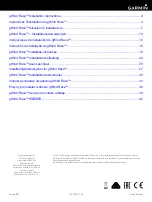
SCT-20 Series
2
Visit our website
1.2 Equipment Recommendations
Failure to follow the installation recommendations is considered a misuse of the equipment.
To Avoid Equipment Damage
•
Keep away from heat sources and direct sunlight.
•
Protect the instrument from rain.
•
Do not wash, dip in water or spill liquid on the instrument.
•
Do not use solvents to clean the instrument.
• Do not install in areas subject to explosion hazard.
1.3 Installation Guidelines
If the unit gets too hot, it can stop communicating.
When the SCT-20 is installed inside of the electrical panel, it is recommended that the units be installed vertically to a horizontal
DIN rail. This minimizes heat buildup from multiple units being stacked and also enables optimal ventilation through the unit. If
possible, it is recommended that the unit be installed towards the bottom of a panel to avoid the warmest parts of the panel. If
panel size is small, some air circulation may be required.
1.4 Weighing Instrument Installation
The terminals to be connected to ground, as indicated on the SCT Weight Transmitter wiring guide, must have the same
potential as the scale structure ground. If unable to ensure this condition, connect a ground wire between the SCT Weight
Transmitter and the scale structure.
The load cell cable must be run separately to the SCT Weight Transmitter input and not share a conduit with other cables. A
shielded connection must be continuous without a splice.
Use RC filters (quencharcs) on the instrument-driven solenoid valve and remote control switch coils. To avoid electrical noise in
the SCT Weight Transmitter panel, use special filters or sheet metal partitions to isolate. The panel installer must provide
electrical protection for the instruments (fuses, door lock switch, etc.). It is recommended to leave the equipment powered on at
all times to prevent the formation of condensation.
Maximum Cable Lengths:
• RS-485: 1000 meters with AWG24, shielded and twisted cables
• RS-232: 15 meters for baud rates up to 19200
1.4.1 Load Cell Installation
The load cells must be placed on rigid, stable structures within 0.5% of plumb and level. It is important to use the mounting
modules for load cells to compensate for misalignment of the support surfaces.
Use waterproof sheaths and joints in order to protect the load cell cables.
Mechanical Restraints
When pipes are present, the use of hoses and flexible couplings and rubber skirted joints is recommended. In the event of rigid
conduit and pipes, place the pipe support or anchor bracket as far as possible from the weighed structure (at a distance at least
40 times the diameter of the pipe).
Welding
Avoid welding with the load cells already installed. If this cannot be avoided, place the welder ground clamp close to the
required welding point to prevent sending current through the load cell body.
Windy Conditions - Shocks - Vibrations
The use of weigh modules is strongly recommended for all load cells to compensate for misalignment of the support surfaces.
The system designer must ensure that the scale is protected against lateral shifting and tipping relating to shocks and vibration,
windy conditions, seismic conditions and the stability of the support structure.
IMPORTANT
IMPORTANT







































